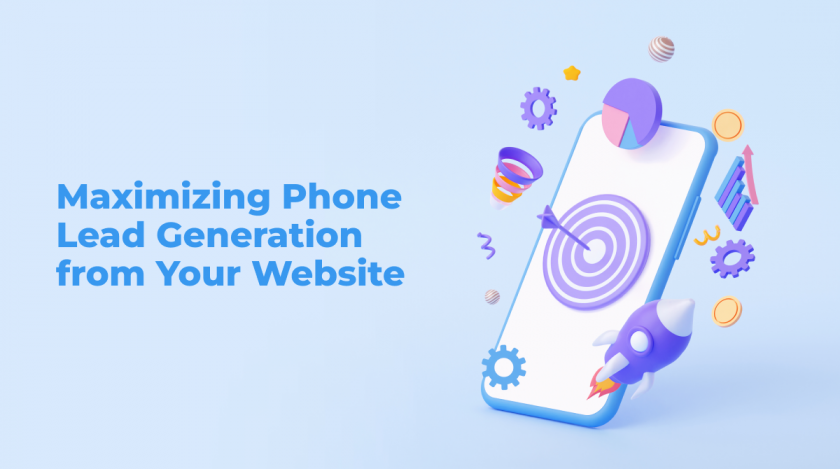In today’s digital age, a website is a crucial tool for businesses to attract and engage potential customers. However, simply having a website is not enough to ensure success. To truly maximize its potential, a website must be designed with lead generation in mind. One effective way to generate leads is by using the website to drive phone calls. By encouraging visitors to call, businesses can establish a more personal connection with potential customers and increase the likelihood of conversion. In this article, we will explore practical strategies and tactics that businesses can implement to increase phone leads generation from their websites.
The ability to make calls directly from the site increases the conversion to sales. According to various research, 6 out of 10 customers are ready to discuss prices on the first call. Every fifth user wants to contact the seller when they first learn about the product. Also, 60% of visitors want to talk to the manager when they have explored different options.

The site is to encourage the visitor to make a targeted action. This can be an order of a product, a subscription to a newsletter, registration, or a click on an advertising link. To understand how well the site performs its function, it is enough to calculate the average percentage of users who have completed the target action. For example, 1000 people visited the online store during the day. 30 purchases were made. The ratio of visitors to customers – (30/1000)*100=3%. Markedly, this percentage is called a conversion.
The conversion rate is affected by:
- Traffic attraction channels (contextual advertising leads people who are ready to buy. Search engine promotion for information queries – people who are looking for an answer to a specific question).
- The convenience of the site (clear navigation, the minimum number of steps before the conversion, the mobile version, and the presence of distracting elements).
- The quality of the content (text, images, and videos should be informative, unique, useful, and properly designed).
- Evidence of decency and qualifications (reviews, certificates, cases, guarantees, payment security).
- Site reliability, page loading speed, availability of conversion elements, etc.
The conversion of the entire site can be divided into several conversions on the way to making a purchase. For example, the conversion of adding an item to the cart, going to the payment stage, placing an order, and confirming the order. Each of these stages may have a different conversion. For example, 30% of people placed an order after adding an item to the cart. An increase in this conversion will lead to an increase in the overall effectiveness of the site.
Conversion can and should be improved. We have collected 10 recommendations to increase the effectiveness of the site, relevant for online stores, landing pages, online services, information portals, and other web resources to get more phone leads from the site.
Improving the usability of the site
1. Place the phone number on the main page
The phone number is often hidden on the contact page. This is logical but forces the user to make additional transitions to find the number and contact the company. Make sure that potential customers see the phone number on the main web pages. Let your contacts be available to the site visitor in the header and footer of the pages.
The user should have several ways to contact you and it should be easy, for example, there are click-to-call widget options that are provided by modern virtual communication providers, like MightyCall, for example. The easier it is to find this information, the more calls you will receive.
If customer requests are processed by a call center, place the phone number in the header and at the bottom of the site. Highlight it against the background of other symbols. Use bold highlighting, larger font size, and different colors.
2. Adapt the website to mobile devices
Adapt the pages of the site so that the design is displayed correctly on mobile devices and so that all the functionality of the site is convenient to use on a smartphone. For example, it is inconvenient to scroll horizontally through text and images when they are wider than the screen, to change the scale with a small font, or to touch navigation elements when they are located close to each other. Additionally, using a video compressor can help optimize any embedded videos on your site, ensuring they load quickly and play smoothly on mobile devices without compromising quality, thereby enhancing the overall user experience.
To optimize the mobile version of your website for phone leads generation, there are several key factors to consider. First and foremost, check how the site displays the phone number and whether it is easily visible to users. Additionally, ensure that the “call by click” buttons are convenient to press and that you have set the correct phone number for the “click to call” feature. Furthermore, take the time to assess how the callback form and other widgets appear on mobile devices to ensure a seamless user experience.
Mobile user experience is critical for high conversion rates. The technical approach to mobile optimization (adaptive layout vs. mobile site) doesn’t affect SEO significantly.
The adaptive design eliminates the need for a separate mobile website version, offering advantages such as a single URL for desktop and mobile, no duplicate pages, and no need for an alternative page structure. With just CSS file modifications and minor layout changes, the desktop version can work effectively on mobile devices.
The mobile site also has advantages:
- The ability to switch to the full version of the site at will.
- Page loading can be accelerated by removing unnecessary functionality that is needed only for desktops.
- You can add functionality that is not needed on the web version.
3. Website design
Design is the first thing a site visitor sees. If the user liked the design of the page, the probability of conversion increases. According to a study by Adobe, two-thirds of users prefer to see beautifully designed content on websites. In the same study, it was revealed that 38% of people immediately leave a site with an unattractive design.
What can be done to improve the design:
- Use the rule of thirds.
- Follow Hick’s law.
- Consider the F-model of the page view.
- Choose the right color scheme.
- Use negative space.
4. Clear navigation
Navigation is the principle of switching between the pages of the site. The way the user finds the necessary information and moves to the pages of the second level of nesting. The site visitor has several navigation tasks:
- To understand where it is and how to get back here.
- Get acquainted with up-to-date information.
- Get into your account.
- Find information/product/service.
- Read the offer/switch to another one.
- Purchase a product /find a company in the real world.
- The task of the site is to help solve these problems. The sooner the better.
There is a three-click rule. It says that to visit any section of the site, you need to make no more than three transitions. Each subsequent click will reduce the number of users who will reach the final section.
5. Site search
Site search helps users to find something specific quickly. It is especially important for catalogs, large blogs, and online stores. The more information posted on the site, the harder it is to find what you need.

Conversion elements
6. Use a powerful call-tracking system
A good and powerful call-tracking system like CallRail, for instance, makes it simple to understand where your calls come from. This way, you can easily filter your digital marketing strategy by maximizing inbound calls. Try Googling your website to see if you can easily find your contact information. Checking to see if there is a CTA on every page and if they all work consistently and seamlessly is a good idea because it helps you determine whether customers can contact you without any problems.
7. Conduct A/B testing
The color, design, font, and location of the number on the page affect the ease of its search, and, therefore, the number of calls received. To determine the optimal location of the number on the site, conduct A / B testing.
To get reliable test results, change only one element in the display of the phone number. For example, in one version of the web page, place the contact number in the upper right part of the site, and in the second version – in the central part of the header. This will make it clear which location brings more calls. You can also test the color or font design of the rooms.
Change the configuration of the contact number or other element on a separate landing page or all pages of the site. Analyze the test results by profit indicators and increase the effectiveness of your marketing.
8. Use the call as a call to action in blog articles
The blog usually offers to follow the link, fill out a form, or view contacts. Simplify the user’s path to calling the manager – integrate the ability to call into texts.
To place such a call, select the appropriate content. The value of a telephone conversation with the manager should be clear to the user.
For example, in an article about the work of complex software, add a widget with a call to call the manager and get advice. Or in the material about the new service, you can place a pop-up window with a call to leave your number for a callback to ask questions.
To enhance the mobile user experience on your website, it’s crucial to ensure that the site’s phone number is prominently displayed and easily accessible to users. By adding a “click-to-call” button, users can effortlessly connect with your business without having to manually dial the number. This simple feature can significantly increase the chances of converting mobile visitors into leads.
9. Callback form
Access to the site is possible at night. If the users do not see the callback form, most likely they will not call back. Invite the visitors to leave a number and choose a time when it will be convenient for them to receive a call.
The first criterion for choosing a service is to customize the appearance of the widget. The second criterion is the ability to control the widget (the time of the pop-up window display, fixed position during scrolling, display when re-entering, etc.). The third criterion is the cost and pricing principle: payment for minutes, for a package of services, or for calls that have taken place.
10. Facts and figures
Surely, people love facts and figures. Through them, you can demonstrate advantages, and prove a high level of competence and reliability. You can add icons, images, and graphs to the block with numbers.
What figures and facts can be used:
- What is the number of registered users?
- How many products and orders have been completed?
- How long has the company been in the market?
- In how many cities does the company have branches?
- Market share.
- Average check.
- Percentage of satisfied customers.
While it may be tempting to exaggerate or embellish information on your website, it’s important to remain truthful and transparent. If there’s nothing noteworthy to share, it’s better to avoid posting figures and facts altogether. Instead, focus on unique selling points such as personalized attention, competitive pricing, a dynamic company culture, or a team of seasoned professionals. Avoid using generic clichés that customers encounter on countless other websites.
Maximizing Phone Leads Generation: Summing Up
You have the necessary tools. It is now time to put the strategy together. Use the results of your tests, as well as feedback from your heat maps and Google Analytics data, to create a more actionable online presence. Maintain a conversion-focused digital marketing strategy and invest in techniques that advance your business goals. Oh, and do not forget to pick up the phone.















